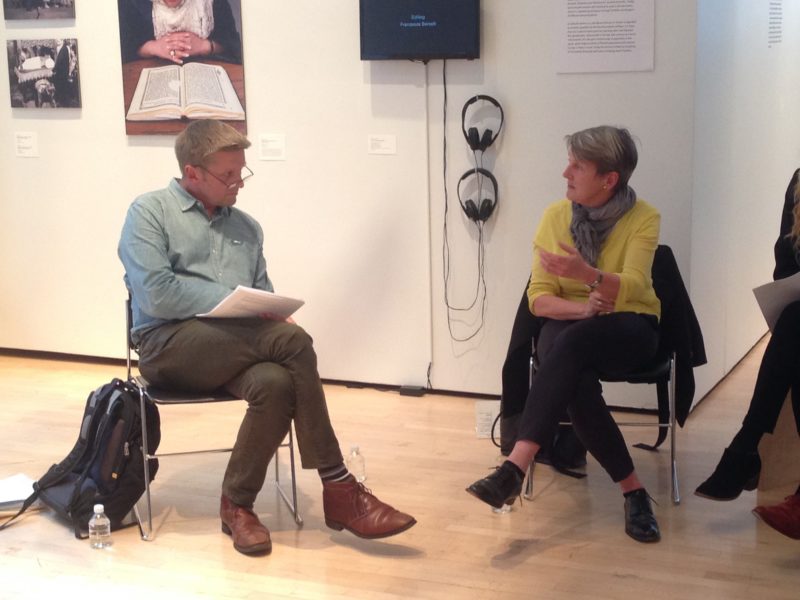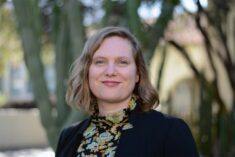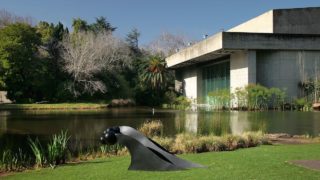In the past couple of months alone, there has been a slate of articles in the international media devoted to Portugal’s contemporary art scene, and the much-criticized current real estate and tourism boom in Lisbon.[1] It is perhaps fitting, then, that the Center for the Humanities’ Director Keith Wilson invited Penelope Curtis the Director of the city’s most beloved art institution, the Calouste Gulbenkian Museum, for an informal conversation in the James Gallery about her work there, as well broader themes throughout her career as a curator in some of Europe’s most important art institutions. It provided three case studies as models of how curators can troubleshoot re-molding institutions during times of change.
Curtis, a British art historian with a PhD from the Courtauld Institute of Art who specializes in modern sculpture, began at the Gulbenkian in 2015. She was formerly Director of the Tate Britain (2010–2015), where she was in charge of a building project and rehang of the gallery. Prior to her time at the Tate, she served as the Curator of the Henry Moore Institute (HMI) in Leeds for over a decade, where she oversaw a wide-ranging program of exhibitions focused on sculpture and rooted broadly in research and material culture. Wilson, an artist who is also British, has known Curtis since she was Curator of the HMI.[2]
The friendly and informal conversation began with an overview of Curtis’s early career. After an initial experience at the Tate Liverpool, Curtis moved to the Leeds Museum. She worked there as Head of the Centre of Sculpture of the HMI from 1994 to 1999, before becoming the Institute’s Director until 2010. Henry Moore (1898-1986), a British modernist sculptor who had gone to art school in Leeds, had left money in his estate to fund a center for sculpture after his death. Curtis stewarded the growth of the HMI from its inception.
The Leeds Museum and the HMI joined together in a sort of awkward partnership—one, a run-down city museum, the other, a private foundation with a fancy new building, plopped right next door. She solved the tension between the two institutions by trying to build a common collection, both sculptural and archival. Curtis was able to buy the kinds of sculpture (“unashamedly academic”) that the Tate wasn’t purchasing, and she tried to showcase other sculptors that Henry Moore had pushed out of the spotlight during his lifetime.
Both Wilson and Curtis emphasized that one of the unique aspects of the HMI was that it had an incredibly small staff and hosted fellows—artists and curators—which allowed for a great deal of flexibility and spontaneity. They tried to respond to the interests of the fellows and to display new acquisitions as soon as they came into the collection. Curtis pointed out how this differed from the Tate, where new acquisitions went into storage to await cataloguing, and hence they were not accessible for years.
After her time at the HMI, Curtis was hired as Director of the Tate Britain. They had an architect for a new building, she explained, but no content, so her main task was to come up with what would go inside. Curtis outlined several of the challenges that she faced while at the Tate. For instance, because of government budget cuts, they were less able to work with the institution’s collection. She also pointed out that actually utilizing the collection was prohibitively expensive because the offsite storage facility was difficult to access and there was a competitive internal accounting process. Instead, she revealed, they had to make exhibitions “that made money. So, you couldn’t do anything experimental.”
Nonetheless, Wilson insisted that Curtis did make a groundbreaking intervention. She took the museum’s national collection and organized it chronologically, rather than by art movements. This meant that all of the artworks made within certain dates would be shown together, no matter what style they belonged to. This approach highlighted a wider array of artistic contributions in any given time period, rather than reasserting the tired old canons that have often been exclusionary. Curtis added that it was also an effective method for introducing artists who had been historically omitted from certain movements, notably women. The resulting layout was based on concentric rings, with the “national story” running around the exterior part of building and special focus exhibitions relating to the wider narrative on the interior.
This led them to Curtis’s current project in Lisbon at the Gulbenkian Museum, which she described as “another redesign project, but not as big as the Tate.” She is the first non-Portuguese director of the art galleries, which house a collection of approximately 6,000 works accumulated by the Armenian oil magnate Calouste Sarkis Gulbenkian. A British citizen who had spent time in Paris and died in Portugal in 1955, Gulbenkian collected Syrian, Egyptian, Iranian, French, and British art during his lifetime (but ironically, he did not collect any Portuguese art). The Gulbenkian Foundation—of which the museum is just one small part—also has offices in London and Paris and is largely philanthropic.
Gulbenkian’s historic Middle Eastern and European collection has traditionally been shown in a separate building from its modern and contemporary exhibitions focused on Portuguese art. Curtis was hired in 2015 to oversee bringing the two collections—the older collection, and the modern collection—together into dialogue. As she pointed out, “the old and new had never worked together until two years ago.” The plan, then, was to unify the teams and find ways for the collections to “speak to each other.”
Overall, the thread running between Curtis’s stints at these three institutions—the HMI, the Tate, and Gulbenkian—was that in each one, she was tasked with spearheading inter or intra-institutional reorganization. At the HMI, she brought together two very different institutions into an unlikely partnership by starting a common collection; at the Tate Britain, her challenge was to modernize the re-hang of its vast collection, and her intervention was to organize it around chronology rather than movements or styles; and at Gulbenkian, she has tried to unite two separate and seemingly disparate collections to provide more unity and context to both.
How successful these models have been is up for debate. On balance, it appears as if the unique partnership between the HMI, heralded today as a global center for the study of sculpture, and the Leeds Museum has been a successful relationship that has benefitted both institutions and the city of Leeds, which now boasts one of the strongest public collections of British sculpture. Curtis’ re-hang at the Tate was more controversial, and as reported in January 2018, its current Director, Alex Farquharson has revealed that he will re-hang the collection again by 2020, returning it to its previous thematic and social approach. Similarly, given what critic Ana Teixara Pinto has described in her recent critical essay about the art scene in Lisbon, as the “generic” institutional landscape there, “marred by mismanagement” and a “lack of institutional continuity,” the results of Curtis’ interventions at Gulbenkian are yet to be determined.[3]
Even so, given that so much critical art discourse these days addresses the need to deconstruct, dismantle, and find ways to work outside of institutions, the benefit of this conversation was the insight it provided into the creative strategies curators can use within institutions. As Curtis pointed out, while many contemporary curators attempt projects outside of institutions, her curatorial projects have always been institutional ones, inside the box, so to say. “Many curators do things outside of institutions,” she explained, “but I’ve always found the institution to be interesting.”
--Gillian Sneed
[1] See, for example: Ana Teixeira Pinto, “The Art of Gentrification: The Lisbon Version,” Afterall 45 (Spring/Summer 2018), accessed May 2, 2018 https://afterall.org/journal/issue.45/the-art-of-gentrification-the-lisbon-version; Lorena Muñoz-Alonso, “Lisbon Has Become One of Europe’s Hottest Art Capitals. How Did That Happen? Just don't call it ‘The New Berlin,’” Artnet News (May 25, 2017), accessed May 2, 2018, https://news.artnet.com/art-world/why-do-artists-love-lisbon-968702; and Benedict Moore-Bridger, “Why Lisbon is becoming Europe’s go-to weekend break destination: Sun, seafood, and stunning scenery,” Evening Standard (April 27, 2018), accessed May 2, 2018, https://www.standard.co.uk/lifestyle/travel/lisbon-portugal-guide-weekend-break-a3824981.html.
[2] The two worked together on the exhibitions Object Sculpture at the HMI in 2002 and Modern British Sculpture at the Royal Academy in 2011.
[3] Ana Teixeira Pinto, “The Art of Gentrification: The Lisbon Version.” Nonetheless, Pinto mentions Curtis’s hiring, and international open-calls, “a welcome development” for Portuguese museums, even if the network is mainly British.


